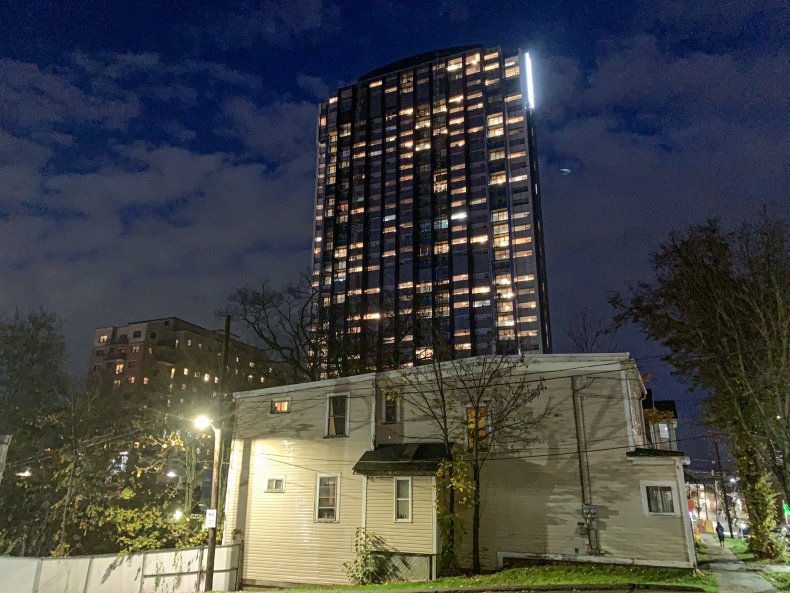Although some experts have long called for taller buildings to accommodate population growth in Canadian cities, elevated office and apartment buildings are not the only solutions for increasing density, according to a recent study. Building their counterparts, mid- and low-rise buildings, can help a city grow, while keeping a significant amount of carbon out of the atmosphere.
The taller the building, the more carbon it emits at each stage of its life. One july study from npj Urban Sustainability found a 140 percent increase in emissions from a neighborhood full of skyscrapers compared to an area of low- and mid-rise buildings. The authors found that increasing the number of mid-size buildings could accommodate growing populations more sustainably than cities focused on single-family homes and skyscrapers because they emit less carbon.
Tall buildings have high emissions once they are built due to complex heating and cooling systems and other operations. But they also impact the environment even before the lights are turned on.
A new Halifax study examined carbon production from two developments that propose to tear down more than a dozen low-rise buildings near the city center and replace them with four high-rise towers. Buildings for the Climate Crisis: A Halifax Case Study, written by environmental scientist Peggy Cameron, found that a significant amount of “embodied carbon” would emerge from the construction of the towers with cement and steel. It found that renovating most of the existing low-rise buildings and constructing a nine-story landfill project would emit 40 percent less carbon than the proposed new construction, while still increasing density.
Incorporated carbon, explains Cameron, constitutes all the emissions produced during the construction phase of a structure, from the manufacture of materials such as windows and doors to the transport of those materials and then the energy consumed during construction. Carbon released during demolition is also taken into account.
Tom-Pierre Frappé-Sénéclauze, director of buildings and urban solutions at the Pembina Institute, agrees: accounting for embedded carbon is essential.
Steel and concrete are typically used to frame tall buildings, which are high-emitting materials, while wood, which can sequester carbon, can be used for low- and mid-rise structures, he explained. Although there are some low carbon concrete options, they are not normally used.
What people are reading

“Typically, the tallest story buildings will be built with concrete and steel,” he said.
“… In the most common building practices, if they are not forced or encouraged to reduce carbon emissions from concrete and steel, they will use cheap material. And it is not always a question of price, it is also what engineers are used to ”.
Worldwide, total emissions from buildings, including embodied carbon emitted during construction, composed of 38 percent of carbon emissions from energy in 2019. Embodied carbon is responsible for a quarter of those emissions. There are no official Canadian figures for embodied carbon.
Towering apartment and office buildings are not the only solutions for increasing density. Building their counterparts, mid- and low-rise buildings, can help a city grow and keep a significant amount of carbon out of the atmosphere. #Emissions
That number is important, said Cameron, who explained that most green building conversations have to do with the operational carbon emissions that are released once a building is finished. She sees a disconnect between the drive to increase density in Halifax and the need to build skyscrapers. Cities like Paris maintaining a high density with a low-rise environment, and wondering why Canadian cities can’t do the same.
So while the federal government is working to reduce operational carbon emissions through net-zero building codes and modifications, Cameron said a significant amount of emissions is being ignored. Leaving embedded carbon out of the calculation makes it much easier to justify tall buildings, green or not, he said.
“If we don’t look at the carbon incorporated in the products we are using, we are actually doing more damage than if we just sat and turned on the heat in our old, leaky houses,” he said.
“Many people have the misperception that when we are building green buildings, and there are so many different standards that are certified, we are doing the right thing for the environment. But, in fact, this is not the case. “
Cameron’s study looked at two adjoining skyscraper development proposals. It found that they would release 31,000 tons of carbon dioxide equivalents (CO2e), or the emissions of 9,497 passenger vehicles, into the atmosphere during the demolition and construction process.

“That means that by keeping existing buildings, where possible, and constructing mid-rise rather than large buildings, the carbon incorporated from the block remodeling can be reduced by more than 40 percent (13,000 tonnes of CO2e),” it read. in the report.
“This amount of carbon emissions is equivalent to about 17 years of operational carbon from existing buildings.”

It is also important to change zoning regulations to disallow tall buildings that cannot be carbon neutral or carbon negative. The fill options show a realistic alternative that could cause much less carbon to enter the atmosphere, he said.
Cameron points to the Royal Institute of British Architects asking for a stop to all demolition and the City of London reject a project due to its estimate of carbon incorporated as positive moves towards recognizing how interrelated construction processes and climate change are.
“I think we have to imagine how we are going to regulate both embodied and operational carbon emissions in the building and construction industry, and then have legally binding targets, and they should be year after year,” he said.
“And they have to start immediately.”
Reference-www.nationalobserver.com